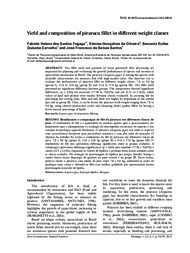Yield and composition of pirarucu fillet in different weight classes.
Yield and composition of pirarucu fillet in different weight classes.
Author(s): FOGACA, F. H. dos S.; OLIVEIRA, E. G. de; CARVALHO, S. E. Q.; SANTOS, J. F. de S.
Summary: The fillet yield and quantity of waste generated after processing are important for planning and evaluating the growth performance of species and systems of aquaculture production in Brazil. The pirarucu (Arapaima gigas) is among the species with desirable characteristics for intensive fish with high market value. The objective was to evaluate the performance of pirarucu fillet in different weight classes: 7.0 to 9.0 kg (group I), 11.0 to 13.0 kg (group II) and 14.0 to 17.0 kg (group III). The fillet yield presented no significant difference between groups. The composition showed significant differences (p < 0.05) for moisture (77.96 to 75.04%) and ash (2.21 to 2.46%), while values of lipid and protein were similar between classes evaluated. In assessing the fat percentage per serving (loin, belly and tail) there was higher fat deposition in the ventral part and in group III. Thus, it can be lessen the pirarucu with weight ranging from 7.0 to 9.0 kg, using shorter production cycles and obtaining better quality fillets by having a lower muscle percentage of lipids.
Publication year: 2011
Types of publication: Journal article
Unit: Embrapa Mid-North
Keywords: Arapaima gigas, Filetagem, Peixe, Rendimento
Observation
Some of Embrapa's publications are published as ePub files. To read them, use or download one of the following free software options to your computer or mobile device. Android: Google Play Books; IOS: iBooks; Windows and Linux: Calibre.
Access other publications
Access the Agricultural Research Database (BDPA) to consult Embrapa's full library collection and records.
Visit Embrapa Bookstore to purchase books and other publications sold by Embrapa.

